Capricious to care for, but very productive and tasty German potato variety “Merlot”
Merlot potatoes are a variety of German selection. It appeared on the Russian market relatively recently, but has already managed to win the love of farmers and consumers. Despite the demands on watering and fertilizing, the crop is among the leaders in cultivation in the central regions of the country. The tubers attract attention with the rich red hue of the peel and the bright yellow color of the pulp.
From the article you will learn how to grow Merlot potatoes, what difficulties farmers may encounter in the process and what ways to eliminate them.
Origin and description of the variety
Merlot potatoes are a late-ripening variety, which was developed by biologists of the German company Nordika Nordring kartoffelzucht und vermehrungs GMBH. The culture was included in the State Register of Breeding Achievements of the Russian Federation in 2015.
Variety received permission to grow in The central region, including Bryansk, Vladimir, Ivanovo, Kaluga, Moscow, Ryazan, Smolensk, Tula regions.
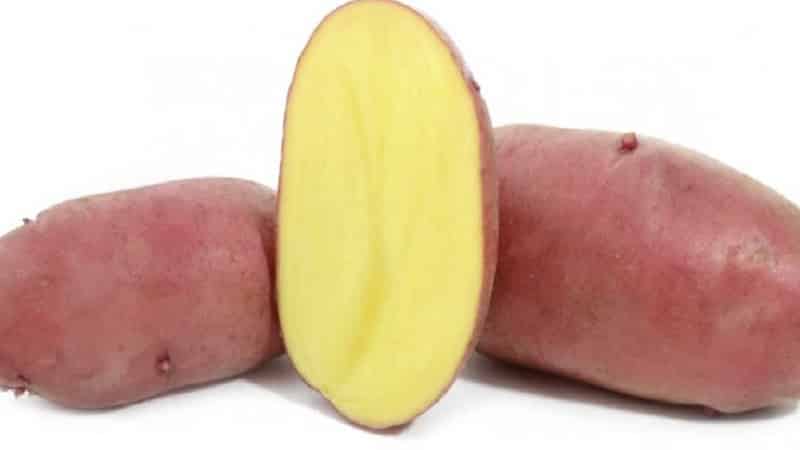
Description and characteristics of the plant are presented in the table.
| Indicators | Characteristic |
| Ripening period | 80-95 days |
| Bush | Medium height, semi-erect, intermediate type |
| Number of tubers in a bush | 6-10 |
| Weight | 90-140 g |
| Form | Oval |
| Coloring | Red skin, rich yellow flesh |
| Leaves | Small, green |
| Corolla color | Red-violet |
| Starch content | 14-16% |
| Taste | Excellent (5 on a five-point scale) |
| Cooking class/group | V/S (medium and highly crumbly) |
| Productivity | Average - 190-355 c/ha, maximum - 504 c/ha |
| Marketability | 84-96% |
| Keeping quality | 98% |
| Purpose | Dining room |
| Sustainability | To cancer, golden nematode, leaf curl virus |
| Transportability | High |
Agricultural technology of culture
Variety Merlot (Merlot) is demanding in terms of care and soil type. It is preferable to grow the crop on black soil, sandy loam, peat, and loam. Potatoes do not tolerate acidic soil well, so it is recommended to conduct a pH test before planting. Optimal indicators are 5.2-5.7. For deoxidation, dolomite flour, slaked lime or chalk are used. Wood ash will help normalize the balance of alkaline soil.
Dates, scheme and rules of planting
Planting work begins in early or mid-May. The soil should warm up to at least +8°C, and the air - to +15°C. According to the originator, the tubers do not need to be germinated. It is enough to soak in a disinfecting solution with copper sulfate, potassium permanganate or in Maxim and growth stimulants Epin, Zircon a day before planting.
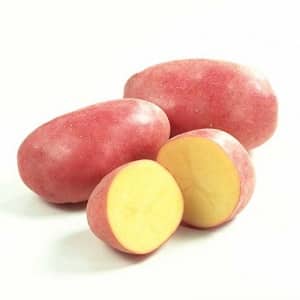 Those who prefer standard pre-plant preparation, 2-3 weeks before planting, place the seeds in sunlight. The optimal germination temperature is +15…+17°C. In such conditions, sprouts will appear in 2 weeks.
Those who prefer standard pre-plant preparation, 2-3 weeks before planting, place the seeds in sunlight. The optimal germination temperature is +15…+17°C. In such conditions, sprouts will appear in 2 weeks.
In autumn, the site is dug up, harrowed, weeds are removed and fertilized with humus.. In the spring, green manure plants (lupine, wheat, flax, peas, rye, oats) are planted and mowed a month later. Plants are planted shallowly in the soil. Rotted green manure serves as an excellent fertilizer, loosens the soil, and inhibits the growth of pathogenic microflora.
The ridges are located in the direction from south to north. This way the potato plantings will receive enough sunlight.
Tubers are planted to a depth of 10 cm with an interval of 35 cm. The width of the rows is 50-60 cm. A handful of ash and superphosphate is added to each hole, sprinkled with earth on top, slightly leveling, but not compacting.
About other potato varieties from German breeders:
Young but promising German potato variety "Krona"
Care
Rules of care:
- Watering. Potatoes need timely and sufficient watering. The frequency of soil moisture depends on the climate. In the southern regions, a drip irrigation system is installed in the plots and water is supplied as the soil dries out. In the regions of the middle zone there is enough precipitation, but during the period of tuber formation, the moisture supply is doubled. The soil is moistened to a depth of 45-50 cm.
- Loosening and weeding. It is recommended to loosen the beds after each watering. Weeding is carried out as necessary, preventing weeds from taking root.
- Hilling. The procedure increases the productivity of the variety by 30-40%. Sprinkling the bushes with soil stimulates the growth of the root system, protects them from night frosts, and ensures unhindered access of oxygen to the tubers, accelerating their ripening. Hilling is carried out when the sprouts reach 10-15 cm in height, during the flowering period, and repeat after 2-3 weeks. The beds are pre-moistened, and after that the procedure begins.
- Top dressing. Potatoes are fertilized three times throughout the entire season. Pay special attention to foliar mineral fertilizing during the growing season, since the plant absorbs only 50% of the nutrients when applied by the roots.
In the table - approximate scheme for fertilizing potatoes.
| Application period | Top dressing | |
| I | Active collection of green mass | 20 g of urea, 20 g of “Effecton” / 10 l of water (for a bush - 500 ml) |
| II | Budding | 200 g of wood ash, 20 g of potassium sulfate/10 l of water (500 ml - under the bush) |
| III | Bloom | 20 g superphosphate, 20 g Effekton/10 l water (500 ml for spraying) |
Nuances of cultivation and possible difficulties
To increase productivity follow the rule of crop rotation. Potatoes are planted after carrots, cabbage, lupine, alfalfa, cucumbers, peas, and beans. It is undesirable to plant the crop after tomatoes, eggplants, and peppers due to the tendency to the same diseases.
In addition to the traditional method of planting potatoes in beds under a shovel, gardeners practice the barrel growing method. This method is suitable for those who are limited in space, but do not want to be left without potatoes for the winter.
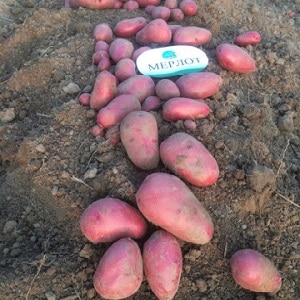 Benefits of technology:
Benefits of technology:
- space saving;
- no need to weed or hill up plants;
- protection of bushes from fungi and insect pests;
- resistance of tubers to rotting;
- reduction of labor costs;
- reduction of the ripening period.
Flaw — careful preparation of the soil and collection of containers for growing are required.
Technological process:
- To grow potatoes, metal and plastic barrels with a volume of 7 liters or more and a height of 30 cm are used.
- The bottom of the containers is cut out and the inside is treated with boiling water and soda. Then wipe dry with a clean cloth. The outer surface is painted with light-colored paint so that the barrels attract less ultraviolet radiation.
- Through holes with a diameter of 1 cm are cut out every 10-15 cm for ventilation.
- The soil is prepared from compost, turf and humus in equal parts. The earth is first disinfected with a solution of potassium permanganate or copper sulfate.
- The barrels are placed in the selected area and a 10 cm layer of soil and compost is poured onto the bottom. The prepared tubers are laid out along the diameter of the circle with an interval of 20 cm, and 10 cm of soil is poured on top.
- After the sprouts appear (2-3 cm), they are sprinkled with a new layer (10 cm) of soil, repeating the procedure until the layer rises to a height of 1 m.
- The bushes are watered 3-4 times per season.
- Plants are fertilized with nitrogen and potassium after the first shoots appear. After flowering, feed with phosphorus.
- The harvest is harvested 3 months after the last portion of fertilizing is applied, when the tops begin to turn yellow and dry. About one bag of potatoes is harvested per 1 m².
Diseases and pests
According to the All-Russian Research Institute of Phytopathology, the variety has moderate susceptibility to the causative agent of late blight on tops and tubers. In unfavorable growing conditions, gardeners are faced with late blight of tubers and tops. The spread of the fungus is facilitated by excessive soil moisture and low air temperature.
The best way to protect plantings is prevention:
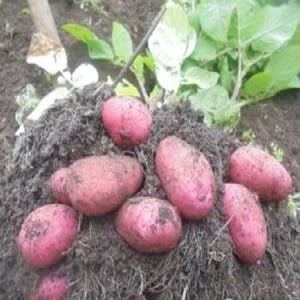 monitoring the level of nitrogen in the soil;
monitoring the level of nitrogen in the soil;- crop rotation;
- cleaning weeds and potato tops;
- soaking tubers in potassium permanganate, Oxyhumate, Fitosporin;
- application of potassium-phosphorus fertilizers;
- treatment of plants with copper-containing preparations and whey with iodine.
At the first sign of infection, the tops are cut off, the bushes are sprayed with “Oxychom”, “Hom”, “Ridomil”, Bordeaux mixture, “Efalem”, “Bravo”. At the stage of tuber formation, the bushes are irrigated with Alufit once.
Potato plantings are more often affected by the Colorado potato beetle than other pests.. Over decades of persistent struggle against it, farmers have developed effective tactics that take into account the beetle’s high adaptive abilities to fungicides.The best results can be achieved with a combination of chemicals and folk remedies.
Beetle larvae cause maximum damage during flowering and tuber formation. If the infestation area is small, the pests are collected manually by throwing them into a jar with a strong saline solution. With widespread distribution:
- dust the bushes with birch ash, gypsum, corn flour;
- water the bushes with a solution of birch tar (100 ml/10 l), infusion of sunflower (100 g of flowers/10 l), celandine (1 kg of grass/10 l), tobacco (500 g of tobacco dust/10 l);
- treat the plant three times with sunflower oil (200 ml/10 l);
- irrigate the plantings with “spray” 1-2 times a week (200 g of soda, 200 g of pressed yeast/10 l);
- they use fungicides “Stop-beetle + Eco potassium humate”, “Ampligo”, “TurboPresto”, “Rescuer of the garden”, “Troyan”, “Kolibris”;
- fragrant tobacco, marigolds, coriander, calendula, nasturtium, matthiola, and borage are planted nearby (to repel);
- attract ants, guinea fowl, starlings, ladybugs, goldeneyes, and ground beetles.
The Colorado potato beetle can hibernate for up to three years., which allows him to wait out the hungry years. After this, he reproduces healthy offspring.
Click beetle larvae (wireworms) “sit” in the ground, weeds and infect potato tubers, gnawing through holes in them. This leads to decay.
Effective against wireworms:
- treatment with chemicals “Aktara”, “Bazudin”, “Prestige”, “Diazinon”, “Grom”, “Gromoboy”, “Zemlin”;
- watering the holes with a pink solution of potassium permanganate before planting;
- adding onion peels to each well;
- watering the bushes with herbal infusion (200 g of nettle, 100 g of dandelion and coltsfoot, 50 g of celandine / 5 l of warm water, leave for 24 hours).
Collection, storage and use of crops
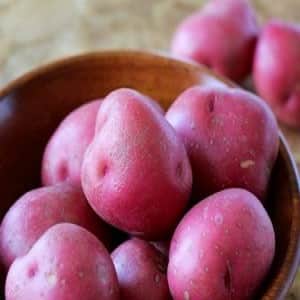 WITHHarvesting is carried out in mid or late September. The tubers are cleared of soil and left to dry in the shade for 3-4 days. Then the potatoes are sorted, damaged specimens with traces of rot are discarded.
WITHHarvesting is carried out in mid or late September. The tubers are cleared of soil and left to dry in the shade for 3-4 days. Then the potatoes are sorted, damaged specimens with traces of rot are discarded.
The harvest is stored in a dry, cool place at temperature +2...+3°C and air humidity - 70-80%. A cellar or basement in a garage is ideal. On a balcony or loggia, potatoes are stored in wooden double boxes, which are inserted into each other like a nesting doll. In a larger box, in the gaps, foam is placed or sawdust is poured. For storage, use blind boxes with a lid, insulated with a foil screen. The containers are placed on a hill so that the bottom does not touch the cold floor in winter.
Heated “balcony cellars” are available for sale. They look like large hiking backpacks, are powered, are wall-mounted, and can withstand temperatures down to -40°C.
Potato Merlot has a wonderful taste and attractive presentation thanks to the red thick peel and rich yellow flesh. The optimal starch content makes it possible to prepare boiled, fried, stewed, baked dishes from it. The tubers do not darken after cutting raw and do not boil in water.
Read also:
Reliable and beloved by farmers potato variety "Alvara"
Advantages and disadvantages
Advantages:
- high productivity;
- resistance to major nightshade diseases;
- long shelf life;
- attractive appearance of tubers;
- pleasant taste and moderate starch content;
- possibility of transportation over long distances.
Flaw — demands on soil type, watering and fertilizing.
Farmer reviews
Reviews about the German Merlot variety are positive. Farmers value the crop for its high productivity, quality, presentation and shelf life, consumers like the pleasant potato taste.
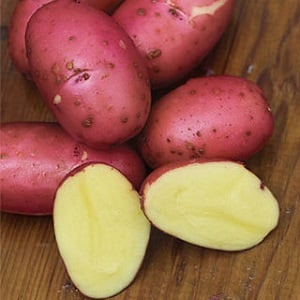 Vladislav, Roslavl: “What kind of potato varieties have I not grown in my entire farming practice? I try to periodically update planting material, looking for new interesting crops. Merlot potatoes attracted attention with their appearance: red skin and rich yellow flesh. Potatoes are very tasty, can be stored for a long time, do not spoil, and the skin does not crack when cooked.”.
Vladislav, Roslavl: “What kind of potato varieties have I not grown in my entire farming practice? I try to periodically update planting material, looking for new interesting crops. Merlot potatoes attracted attention with their appearance: red skin and rich yellow flesh. Potatoes are very tasty, can be stored for a long time, do not spoil, and the skin does not crack when cooked.”.
Victoria, Kaluga: “Two years ago, Merlot potatoes became one of our favorites. The culture requires a meticulous approach to watering and fertilizing, but for me this is not a drawback. I feed the bushes three times: after planting, during the flowering period and two weeks after it. I installed a drip water supply system on the site, I carry out loosening and weeding in a timely manner.”.
Conclusion
Merlot potatoes are a German late-ripening variety characterized by high productivity, excellent presentation and taste of tubers, keeping quality and long shelf life. The culture is resistant to most diseases, but in conditions of high humidity it is prone to late blight.
Maintaining crop rotation, pre-planting treatment of tubers, preventive spraying of bushes with preparations containing copper, and removing weeds can minimize the risk of infection. Modern fungicides and old, but proven folk remedies will help get rid of the Colorado potato beetle and wireworm.